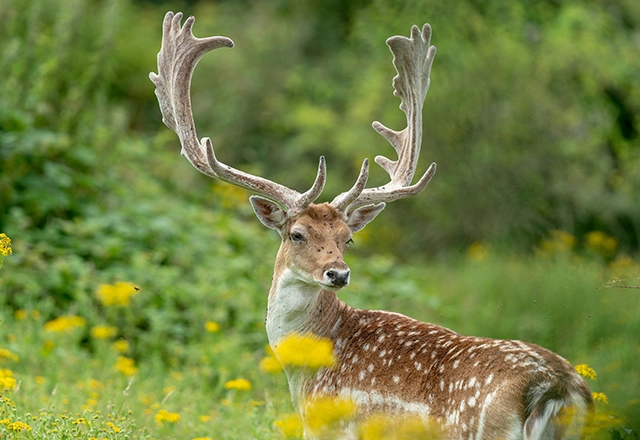New research supports conservation of fallow deer across Europe
New research has combined zooarchaeology and ancient and modern biomolecular datasets to reveal a new understanding of the history and projections of fallow deer.
16/04/2024 By BGS Press
For the last 10 000 years, humans have manipulated fallow deer populations with varying outcomes. Persian fallow deer (Dama mesopotamica) are now endangered, whilst European fallow deer (Dama dama) are globally widespread and are simultaneously considered wild, domestic, endangered and invasive.
Fallow deer populations
New research led by Durham University and the University of Exeter combined DNA analyses with archaeological approaches, including isotope analyses in collaboration with BGS. This multi-proxy approach suggests that, after the last glacial maximum, there were two distinct European fallow deer populations. The analysis revealed that Persian fallow deer were more widespread than has previously been proposed, whilst European fallow deer were likely restricted to Anatolia and the Balkans, and two distinct populations existed on either side of the Bosphorus, a waterway in Istanbul, Turkey.
Additionally, tracing their spread reveals that fallow deer were repeatedly sourced from the furthest available populations. The Neolithic deer on the Aegean island of Chios, and likely Rhodes, derived from the Balkans, rather than nearby Anatolia, whilst those on Majorca in Roman times were D. mesopotamica rather than the D. dama, which could have come from the Iberian peninsula. As well as this, the deer reintroduced to medieval Britain were brought from Anatolia instead of Iberia or Italy, as previously thought.
Re-establishing fallow deer
There are several active campaigns to re-establish fallow deer in the Balkans and preserve the last remaining wild herd in Daği-Termessos National Park, Turkey. However, without knowledge of the species’ deep-time biomolecular and phylogeographic history, deer are being sourced from the least appropriate populations. For instance, those being reintroduced to the Balkans possess Anatolian ancestry.
Furthermore, these Anatolian deer are being introduced to regions that have, for thousands of years, preserved deer with Balkan ancestry. Whilst Anatolia-derived deer are increasing in numbers around the world, the Daği-Termessos herd is still under threat. The research suggests that north European deer of Anatolian ancestry could be introduced to the Daği-Termessos park, while Iberian/Italian/Rhodes deer populations would be a better source for Balkan rewilding projects.
Future protection?
Ancient dispersals of people, ideas and animals are widely celebrated as cultural heritage. However, this study found that the more recent the animal migration, the more negative the attitude is towards them. Such perceptions can translate into animal management and policymaking.
The fallow deer of Rhodes were introduced during the Neolithic and are viewed as a cultural asset, protected by Greek law and featured on the International Union for Conservation of Nature (IUCN) Red List. The fallow deer of Barbuda are equally culturally significant as the island’s national animal, yet they have no legal protection and are labelled as ‘invasive’ within the conservation literature. In truth, they are dismissed only because their introduction occurred too recently to have acquired a patina of age-based authenticity.
While many species may legitimately be labelled as invasive, this is not true of all translocated populations, and some do deserve protection. Preoccupation with native and wild species can come at the expense of often equally endangered translocated animals that are not only critically entangled with human history but also offer a conservation resource for replenishing diminished autochthonous or indigenous populations. This study suggests it might be time to rethink our attitudes towards animals with the planet’s biodiversity crisis.
A total of 418 specimens were submitted for multi-element isotope analyses at the laboratory with the results providing information on the environmental conditions the deer were living in and their diet, thus improving our overall understanding of the species’ ecological history.
Angela Lamb, BGS Isotope Geochemist.
More information
Relative topics
Related news

Geology sans frontières
24/04/2025
Geology doesn’t stop at international borders, so BGS is working with neighbouring geological surveys and research institutes to solve common problems with the geology they share.

Artificial intelligence is proving a game changer in tracking the Santorini earthquake swarm
07/02/2025
Scientists are harnessing the power of machine learning to help residents and tourists by detecting thousands of seismic events.

Carbon and oxygen isotope analysis of carbonates and the development of new reference materials
18/12/2024
Dr Charlotte Hipkiss and Kotryna Savickaite explore the importance of standard analysis when testing carbon and oxygen samples.

Studying oxygen isotopes in sediments from Rutland Water Nature Reserve
20/11/2024
Chris Bengt visited Rutland Water as part of a project to determine human impact and environmental change in lake sediments.

How can Scotland re-establish its building stone industry?
14/11/2024
British Geological Survey research, commissioned by Historic Environment Scotland, reveals an opportunity to re-establish the Scottish building stone market in order to maintain the country’s historic buildings.

Exploring the role of stable isotope geochemistry in nuclear forensics
09/10/2024
Paulina Baranowska introduces her PhD research investigating the use of oxygen isotopes as a nuclear forensic signature.

BGS collaborates with Icelandic colleagues to assess windfarm suitability
03/10/2024
Iceland’s offshore geology, geomorphology and climate present all the elements required for renewable energy resources.

Laboratory life: my work experience week at BGS
20/08/2024
Aspiring astrophysicist Riveen Pehesara Kumanayaka shares his experience following an A-level work placement with BGS.

Extracting formation temperatures from stalagmites
14/08/2024
BGS’s Andrew Smith explores the karstic depressions of northern Spain in the quest to create a palaeothermometer.

Responsible extraction in South America’s Lithium Triangle
02/08/2024
A BGS team visited Argentina and Chile to investigate how to extract lithium more responsibly in the face of growing worldwide demand.

Creswell Crags Museum collections offer insight into the past and future of wolves
12/07/2024
Bones found at the site are helping scientists to understand the diet of wolves and how they differ over time.

The heat beneath our feet: BGS field visit to Tuscan geothermal systems
05/07/2024
BGS visits the active and fossilised geothermal systems of southern Tuscany, Italy.



